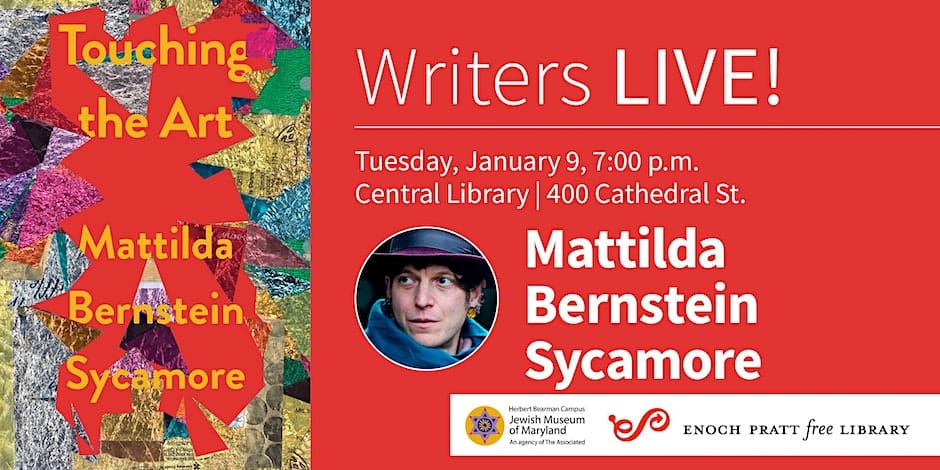I had the unique opportunity to have lunch with Mattilda Bernstein Sycamore in 2018, sometime after she’d arrived in Baltimore to research her new book.
I was a fan of her work already; I remember being pretty excited about Nobody Passes coming out. It was around the time I was touring a bit with the Tranny Roadshow and suddenly I was seeing names of interesting trans artists popping up on maps across the country. The Charm City Kitty Club was in full swing and bringing acts like Robo Sapien and Imani Henry and The Shondes to Baltimore on a regular schedule. It was a time of extreme queer hope. It took years for me to find kindred trans people and it was a joy to see so much sprouting. This is the atmosphere in which I was introduced to Sycamore.
Flash forward a decade and change, and I finally get the chance to meet her. She suggests we meet up at Ida B’s — the excellent restaurant named for famed investigative journalist Ida B. Wells — and as much as I enjoyed the menu and the concept of the spot, it was simply too pricey for me on my little artist’s salary. I agreed, cautiously, and hoped for a filling appetizer, a cheap side salad, maybe a refillable coffee on the lunch menu.
She showed up resplendent in purple. I was surely in one of the dresses I often took from work to the stage on those days when I wouldn’t be able to stop at home before going to my performance venue. I don’t remember what I ate, but I remember learning about her upcoming projects.
The Freezer Door was on the cusp of coming out, which of course sounded thrilling; but then she described what she was planning for her following book — a memoir involving her grandmother, the visual artist Gladys Goldstein, an accomplished abstract artist who taught at MICA for many years. I was about to enter grad school to work on my own project on art and matriarchy, so I felt an immediate kinship to the project she described. “Sign me up,” I said. “I’ll buy two.”
Somehow six years elapsed and now I am holding a copy of that book, Touching the Art. I still need to buy a second copy to keep my word, and it will be worth every cent, because as a queer Baltimore artist, this book strikes me as one of the more important books about Baltimore and art in recent memory, following on The Black Butterfly and Baltimore Revisited.
More specifically, Touching the Art is a book about the shattering and maintenance of illusions. It’s about recognizing the political in the personal. It’s about mentorship and the ways families bury sexual violence. It’s about the ways artists choose to see things or to not see things. It’s about wrestling with unanswerable questions and recognizing what happens when resolution to a conflict is unavailable.
While the artist at the center of this story is a visual artist — primarily a painter and collagist — this book is also about architecture: the architecture of buildings in Baltimore as well as the architecture of the various systems of oppression that impact us, and the ways artists, specifically, are vulnerable to participating in maintaining and uplifting those systems.
One of the more haunting passages comes when Sycamore asks her grandmother if she ever revisits the Baltimore neighborhood in which she grew up, a neighborhood close to the flashpoint of the Baltimore Uprising in 2015. Goldstein responds "you can't," as if the place no longer exists, echoing the famous words of erstwhile Baltimorean Gertrude Stein: “there is no there there.” Stein was speaking of Oakland, California instead of Baltimore, but both places still do very much exist. They’d just changed demographically.
There is so much detail packed into Sycamore’s pages that it’s worth taking slow and sovoring her perspective on what she observed of Baltimore while she walked the streets of Baltimore.
Touching the Art is full of careful and direct observations about Baltimore’s curious landscape and atmosphere, things that maybe long-time residents may not even see anymore. At one point, she describes the Bruce Nauman piece outside of the BMA, the neon sign that alternates “SILENCE,” “VIOLINS,” and “VIOLENCE.” She notes how the piece was once controversial and how eventually Baltimoreans just got used to it.
Sycamore’s distance as an observer affords her the ability to connect threads and ask important questions about the ways investment and renovation have benefited Baltimore — or not. She walks around Station North, noticing all the signs advertising businesses that are no longer there, and pondering the merits of the capital investments in buildings like the Parkway Theater.
And so Touching the Art is also very much a book about gentrification, and the ways marginalized people are pitted against each other. It’s about disposability and the things that persist after a person or a place has been disposed of — the signs, the systems, the energies. Touching the Art is about the things that aren’t there any more, except that they are — and how it’s really the job of the artist to make those things visible, or understandable, or tactile.
UPDATE: Treat yourself to a stream of Mattilda Bernstein Sycamore at the Enoch Pratt Free Library. It's a great Q&A!


